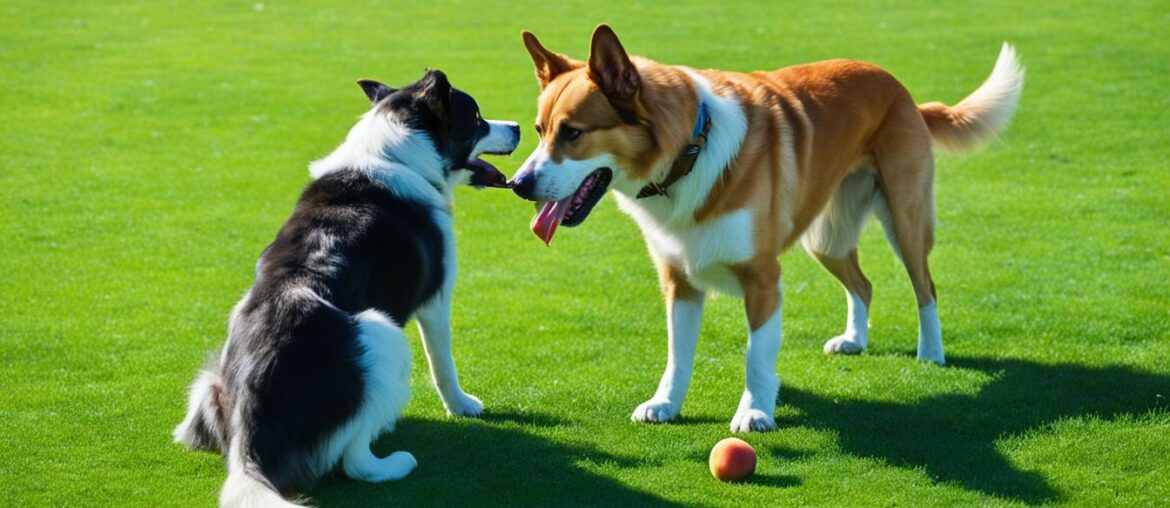As a dog owner, you may have wondered if it’s safe to share a juicy peach with your furry friend. Well, the answer is yes, dogs can have peaches, but there are a few important things to keep in mind before offering this tasty treat to your canine companion.
Peaches can provide some nutritional benefits for dogs. They are a good source of vitamin A and fiber, which can support your dog’s overall health. However, it’s crucial to be cautious and take certain precautions when feeding peaches to your dog.
Key Takeaways:
- Dogs can have peaches in small, cut-up pieces as a treat.
- Avoid feeding your dog canned or preserved peaches due to their high sugar content and potential additives.
- Remove the pit, stems, and leaves before giving your dog a peach, as they contain cyanide, a toxic compound.
- Wash peaches thoroughly to remove any pesticides before feeding them to your dog.
- Monitor your dog for any signs of digestive upset or adverse reactions after introducing peaches into their diet.
Health Benefits of Peaches for Dogs

Peaches offer several health benefits for dogs. They are rich in vitamins A and C, which are essential for immune function and overall health. These vitamins help support the body’s natural defenses and protect against illnesses and infections. In addition to vitamins, peaches also contain other important nutrients that contribute to a dog’s well-being.
Including vitamin E, K, niacin, folate, iron, choline, potassium, magnesium, phosphorus, manganese, zinc, and copper. These minerals play crucial roles in various bodily functions, such as energy production, bone health, and the formation of red blood cells. They also promote healthy digestion, muscle function, and cognitive function in dogs.
Peaches provide a natural source of essential vitamins and minerals that contribute to a dog’s overall health and well-being.
Feeding peaches to dogs in moderation can help boost their immune function, improve nutrient absorption, and support healthy growth and development. They can also provide antioxidant benefits, protecting cells from oxidative damage and reducing the risk of chronic diseases.
However, it’s important to keep in mind that peaches should only be given as a treat and not as a staple in your dog’s diet. Too many peaches can lead to an imbalance in their overall nutritional intake, as peaches are relatively high in sugar compared to other fruits.
As with any food, it’s crucial to introduce peaches gradually and monitor your dog for any adverse reactions, such as digestive upset or allergies. If you have any concerns about feeding peaches to your dog, it’s always best to consult with your veterinarian for personalized advice and recommendations.
| Nutrient | Amount per 100g of Peaches |
|---|---|
| Vitamin A | 326 IU |
| Vitamin C | 6.6 mg |
| Vitamin E | 0.73 mg |
| Vitamin K | 2.6 mcg |
| Niacin | 0.806 mg |
| Folate | 4 mcg |
| Iron | 0.25 mg |
| Choline | 6.1 mg |
| Potassium | 190 mg |
| Magnesium | 9 mg |
| Phosphorus | 11 mg |
| Manganese | 0.086 mg |
| Zinc | 0.17 mg |
| Copper | 0.086 mg |
These nutrient values may vary depending on the size and ripeness of the peaches.
Risks of Dogs Eating Peaches
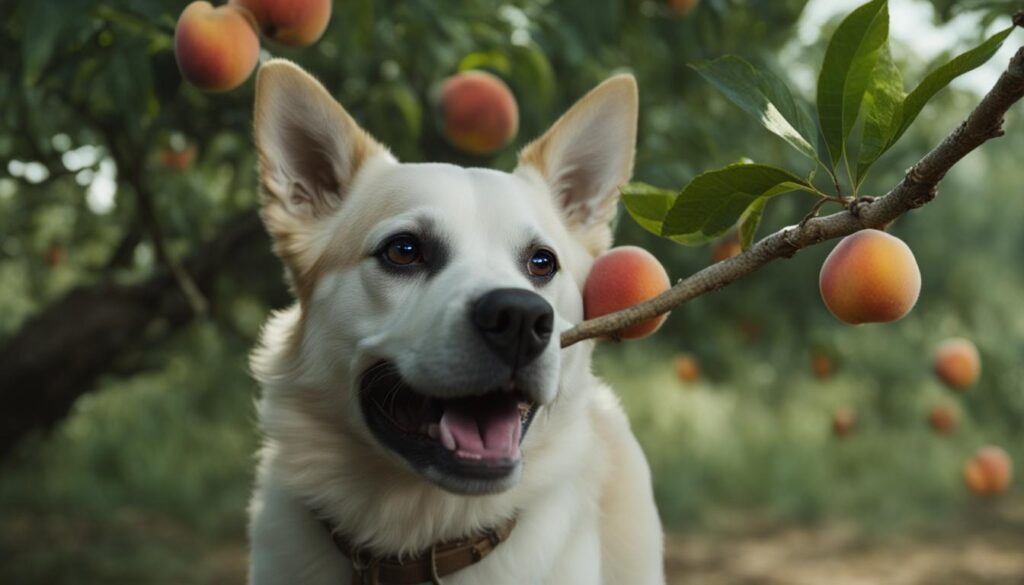
While peaches can be enjoyed by dogs, there are potential risks involved. It’s important for pet owners to be aware of these risks and take necessary precautions when feeding peaches to their furry friends.
High Sugar Content
Peaches, like many fruits, contain a natural sugar called fructose. While small amounts of natural sugar can be part of a healthy diet for dogs, excessive consumption can lead to digestive upset and contribute to conditions like diabetes and obesity.
Cyanide in Peach Pits
The most significant risk associated with peaches is the presence of cyanide in the pit, or stone. Cyanide is a toxic compound that can have serious consequences if ingested by dogs. It can cause choking, intestinal blockage, and damage to the esophagus and intestines.
To illustrate the potential risks, here’s a table comparing the nutritional content of peaches and the potential risks:
| Nutrient | Peaches | Potential Risks |
|---|---|---|
| Sugar | High sugar content | Risk of digestive upset, diabetes, and obesity |
| Cyanide | Trace amounts in the pit | Potential choking hazard, intestinal blockage, and damage to the esophagus and intestines |
It is crucial to remove the pit and avoid feeding your dog any part of the peach that may contain cyanide to prevent these risks.
While the risks of dogs eating peaches exist, it’s essential to note that these risks can be minimized with proper caution and moderation. In the next section, we will explore the best practices for serving peaches to dogs and ensuring their safety and well-being.
Properly Serving Peaches to Dogs
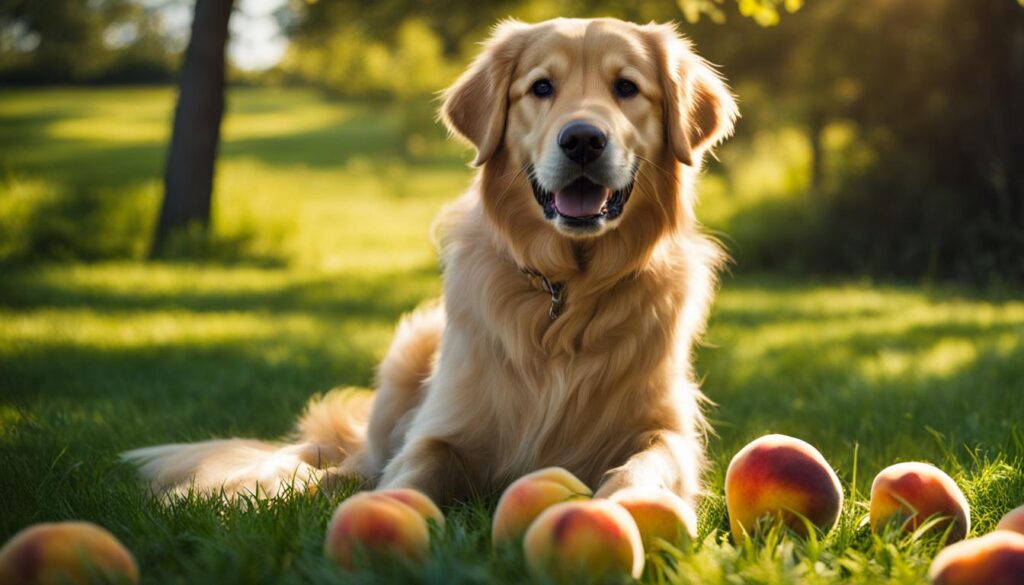
When it comes to serving peaches to your furry friend, it’s essential to do it right. Follow these guidelines to ensure your dog can safely enjoy this delicious fruit.
- Start by washing the peach thoroughly to remove any pesticides or chemicals that may be present on the skin.
- Remove the stem and any leaves from the peach. These parts contain cyanide, which can be harmful to dogs.
- Slice the peach into manageable pieces, removing the pit completely. Be sure to remove the pit entirely, as it can pose a choking hazard and contains toxic compounds.
- You can now feed your dog the fresh peach in slices or smaller chunks, making it easier for them to enjoy. Alternatively, you can freeze the peach slices for a refreshing summer treat.
It’s crucial to closely monitor your dog after introducing peaches into their diet. Watch for any signs of digestive upset or adverse reactions. If you notice any discomfort or changes in your dog’s behavior, consult with your veterinarian.
| Steps for Serving Peaches to Dogs |
|---|
| 1. Wash the peach to remove pesticides. |
| 2. Remove the stem and leaves from the peach. |
| 3. Slice the peach and remove the pit completely. |
| 4. Feed your dog the fresh peach in slices or smaller chunks. |
Can Dogs Eat Peach Fuzz?
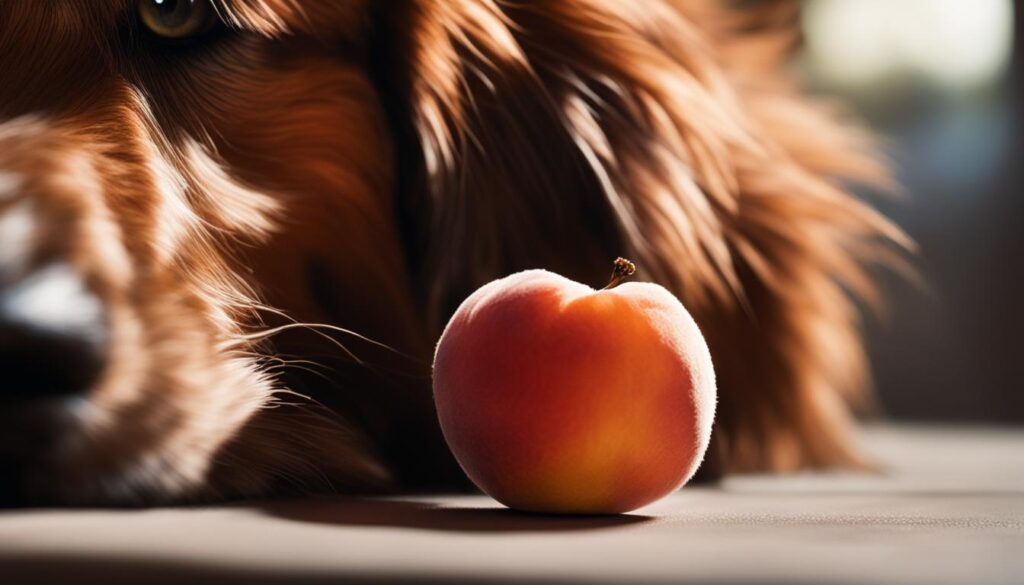
While dogs can safely consume peaches, the question arises – can dogs eat peach fuzz? In general, peach fuzz is not problematic for dogs and can be consumed without adverse effects. However, it’s important to note that some dogs may have a mild oral allergic reaction to the fuzz.
If your dog experiences symptoms such as excessive salivation, rubbing at the face, multiple smacking motions with the mouth, or resistance to eating after consuming peach fuzz, it’s best to avoid feeding them the fuzz in the future.
As with any new food, it’s essential to monitor your dog closely for any signs of discomfort or adverse reactions. If you notice any unusual symptoms, it’s always a good idea to consult with your veterinarian for guidance.
In conclusion, while peach fuzz is generally safe for dogs to eat, it’s important to pay attention to your furry friend’s individual sensitivities and any signs of allergic reactions. When introducing new foods into your dog’s diet, including peach fuzz, it’s best to do so in moderation and under the guidance of a veterinarian.
Signs of Cyanide Poisoning in Dogs

Cyanide poisoning can occur if a dog consumes parts of the peach that contain cyanide, such as the pit, stems, or leaves. It is important to be aware of the signs of cyanide poisoning in dogs so that you can take immediate action if necessary.
Symptoms of Cyanide Poisoning
- Vomiting
- Difficulty breathing
- Skin irritation
- Coma
If your dog accidentally eats a peach pit or shows any signs of cyanide poisoning, it is crucial to seek veterinary care immediately. Time is of the essence when it comes to treating cyanide poisoning, and a veterinarian will be able to provide the necessary medical intervention to help your dog.
Remember, prevention is always better than cure. It is important to remove the pit, stems, and leaves from peaches before feeding them to your dog to avoid any potential risks of cyanide poisoning. By being proactive and vigilant, you can ensure the safety and well-being of your furry friend.
Peach Pits as Choking Hazards and Intestinal Blockage
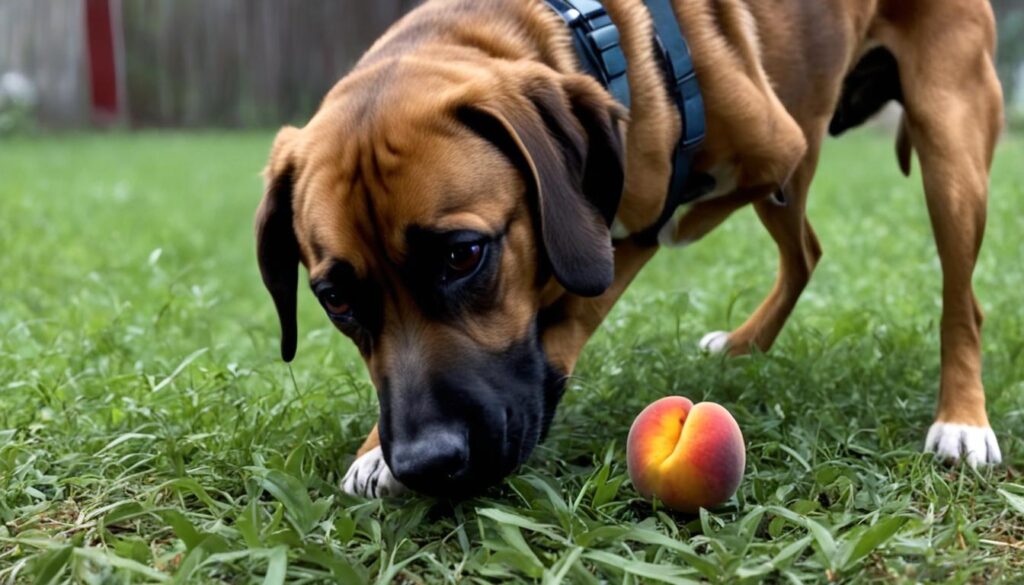
Peach pits can present significant risks to dogs, both as choking hazards and potential causes of intestinal blockage. When dogs swallow peach pits whole, they can become lodged in their throat or esophagus, leading to choking. The larger size of peach pits, especially those found in peaches, apricots, and nectarines, increases the risk of blockage in the intestines.
The ingestion of a peach pit can cause a dangerous condition known as intestinal blockage. This occurs when the pit obstructs the normal movement of food and waste through the digestive tract, leading to a potentially life-threatening situation. Symptoms of gastrointestinal obstruction may include a lack of appetite, vomiting, diarrhea, or constipation.
It is crucial to seek immediate veterinary attention if you suspect that your dog has swallowed a peach pit or is exhibiting symptoms of intestinal blockage. Prompt medical intervention can be vital in removing the obstruction and preventing further complications.
Importance of Moderation and Veterinary Guidance
Feeding peaches to dogs can be a healthy and enjoyable treat, but it is crucial to do so in moderation. Just like any other food, peaches should be given to dogs in controlled amounts. The 90/10 rule is recommended when it comes to treating your furry friend; 90 percent of their daily caloric intake should come from their regular dog food, while only 10 percent should come from treats, including peaches.
To ensure that you are feeding peaches to your dog in a safe and appropriate manner, it is highly advised to consult with your veterinarian. They can provide personalized advice based on your dog’s specific needs and health conditions. Your veterinarian will be able to guide you on the appropriate portion sizes for your dog and advise you on how often peaches can be incorporated into their diet.
Remember, every dog is different, and what may be suitable for one dog may not be for another. By consulting with your veterinarian, you can ensure that you are making the best choices for your dog’s overall health and well-being.
Feeding Peaches in Moderation
Feeding peaches in moderation is key to maintaining a balanced diet for your dog. While peaches do offer various health benefits, excessive consumption can lead to various health risks. Feeding peaches as a occasional treat rather than a regular part of their diet is the best approach.
When introducing peaches to your dog’s diet, it is essential to start with small amounts to gauge their reaction. Observe your dog for any signs of digestive upset, such as diarrhea or vomiting, which may indicate that they are not tolerating peaches well.
Veterinarian’s Advice on Feeding Peaches to Dogs
Your veterinarian is the best source of information when it comes to your dog’s dietary needs. They can evaluate your dog’s overall health, any pre-existing conditions, and advise you on whether or not peaches are appropriate for your dog. Additionally, they can recommend the right portion sizes and frequency of feeding peaches to your furry companion.
Consulting with your veterinarian ensures that you are providing your dog with a safe and balanced diet that meets their individual requirements. They can help you make informed decisions regarding the inclusion of peaches or any other food in your dog’s diet.
Remember, always consult with your veterinarian before introducing any new food to your dog, including peaches.
Benefits and Risks of Feeding Peaches to Dogs
| Benefits of Feeding Peaches to Dogs | Risks of Feeding Peaches to Dogs |
|---|---|
|
|
Fresh vs. Canned Peaches
When it comes to feeding peaches to dogs, it is generally better to opt for fresh fruit rather than canned or preserved options. While canned peaches may seem convenient, they have some downsides that can be detrimental to your dog’s health.
Canned peaches often contain higher levels of sugar compared to their fresh counterparts. Excessive sugar consumption can lead to weight gain, dental issues, and even contribute to the development of diabetes in dogs. Additionally, canned peaches may also contain additives and preservatives that can be harmful to your furry friend.
Furthermore, it’s crucial to be aware of the presence of xylitol in low-calorie, processed fruit products. Xylitol is a natural sweetener that is safe for humans but highly toxic to dogs. It can cause a rapid release of insulin in dogs, leading to a dangerous drop in blood sugar levels.
Feeding your dog fresh peaches ensures that they receive the maximum nutritional benefits of this fruit without any potential harmful additives or excessive sugar. Fresh peaches are a great source of vitamins A and C, as well as other essential nutrients that support your dog’s overall health and well-being.
When incorporating fresh peaches into your dog’s diet, it’s important to follow safe feeding practices. Wash the peach thoroughly to remove any pesticide residues, and remove the pit, stems, and leaves, as these parts of the peach contain cyanide, which is toxic to dogs.
By choosing fresh peaches over canned options, you can ensure that your dog receives a wholesome and nutritious treat. Remember to feed peaches to your pup in moderation and consult with your veterinarian for personalized advice on feeding fruit to your dog.
Other People Foods for Dogs
While it’s natural to want to share various foods with your dog, it’s important to stick to those that are safe and suitable for their digestive system. Dogs have different nutritional needs compared to humans, and certain foods that are harmless to us can be harmful to them. It’s essential to prioritize your dog’s overall well-being when selecting treats and other people foods to share.
Choosing Safe Treats for Dogs
There are many treats formulated specifically for dogs that offer a wide range of flavors and nutritional benefits. These treats are designed to meet the dietary requirements of dogs and are generally safe for consumption. They come in various forms, including biscuits, jerky, dental chews, and training treats, allowing you to choose the most appropriate option for your furry friend.
“Feeding your dog treats formulated for their specific needs ensures that they receive the right balance of nutrients and calories.”
Treats formulated for dogs are often made with high-quality ingredients, avoiding harmful additives and excessive levels of sugar and salt. They are carefully formulated to provide the nutritional benefits without compromising your dog’s health. Additionally, these treats are often designed to promote dental health, encourage chewing, and aid in digestion, offering additional benefits beyond simple rewards or indulgence.
Popular People Foods That Are Safe for Dogs
While some people foods are unsafe for dogs, there are a few options that can be shared in moderation and are safe for consumption:
- Cooked lean meats, such as chicken or turkey, without seasoning or bones.
- Plain cooked rice or pasta.
- Carrots, green beans, or sweet potatoes, cooked and cut into small pieces.
- Plain yogurt or cottage cheese.
- Blueberries, strawberries, or watermelon, cut into bite-sized portions.
Remember, it’s important to introduce new foods gradually and monitor your dog for any signs of adverse reactions or digestive upset. Each dog is unique, and what may be safe for one may not be tolerated well by another.
| Food Item | Serving Size | Nutritional Benefits |
|---|---|---|
| Cooked Lean Meats | Small amounts as a topping or treat | Protein, essential amino acids |
| Plain Cooked Rice or Pasta | Small amounts as part of a balanced diet | Energy, carbohydrates |
| Carrots, Green Beans, or Sweet Potatoes | Cut into small pieces for snacking | Fiber, vitamins A and C |
| Plain Yogurt or Cottage Cheese | Small amounts as a probiotic treat | Probiotics, calcium |
| Blueberries, Strawberries, or Watermelon | Cut into small portions for occasional treats | Antioxidants, vitamins C and K |
Remember, even though these foods are safe for dogs, they should be given in moderation and should not replace a balanced diet specifically formulated for your dog’s nutritional needs. Always consult with your veterinarian before making any significant dietary changes or introducing new foods to your dog’s diet.
Wrapping Up
In conclusion, it is safe for dogs to have peaches in moderation, as they can provide some health benefits. However, there are important precautions to keep in mind when feeding peaches to your furry friend. Peaches should be given in small, cut-up pieces, and it is crucial to avoid the pit, stems, and leaves, as they contain cyanide, which can be harmful to dogs.
Fresh peaches are the best option for dogs, as canned or preserved peaches often contain high sugar levels and potential additives that can be detrimental to their health. It is always recommended to monitor your dog for any adverse reactions or digestive upset after introducing peaches into their diet.
To ensure the safety and appropriateness of feeding peaches to your dog, it is essential to consult with your veterinarian. They can provide personalized advice and guidance based on your dog’s specific needs and health condition. Your veterinarian can also help you determine the appropriate moderation and balance of peaches as a treat in your dog’s overall diet.
FAQ
Can dogs have peaches?
Yes, dogs can have peaches, but there are some considerations to keep in mind.
What are the health benefits of peaches for dogs?
Peaches are rich in vitamins A and C, as well as other nutrients that support overall health and boost immune function.
Are there any risks associated with dogs eating peaches?
Yes, there are potential risks, including the presence of cyanide in the pit, stems, and leaves, as well as the high sugar content.
How should peaches be served to dogs?
Peaches should be washed, sliced, and served without the pit, stems, or leaves. Frozen peaches can also be offered as a refreshing treat.
Can dogs eat peach fuzz?
While peach fuzz is generally not problematic, some dogs may have a mild oral allergic reaction to it.
What are the signs of cyanide poisoning in dogs?
Symptoms of cyanide poisoning in dogs may include vomiting, difficulty breathing, and skin irritation.
Do peach pits pose a choking hazard to dogs?
Yes, peach pits can pose a choking hazard and may cause intestinal blockage if swallowed.
How important is moderation and veterinary guidance when feeding peaches to dogs?
Feeding peaches to dogs should be done in moderation, and it’s always best to consult with a veterinarian for personalized advice.
Are fresh or canned peaches better for dogs?
Fresh peaches are preferable to canned ones, as canned peaches can contain higher sugar content and potentially harmful additives.
What other people foods can dogs safely consume?
There are many dog treats available that are formulated specifically for dogs and offer a variety of flavors and nutritional benefits.
What is the conclusion regarding dogs and peaches?
Dogs can have peaches in moderation, but it is crucial to follow safe feeding guidelines and consult with a veterinarian.


